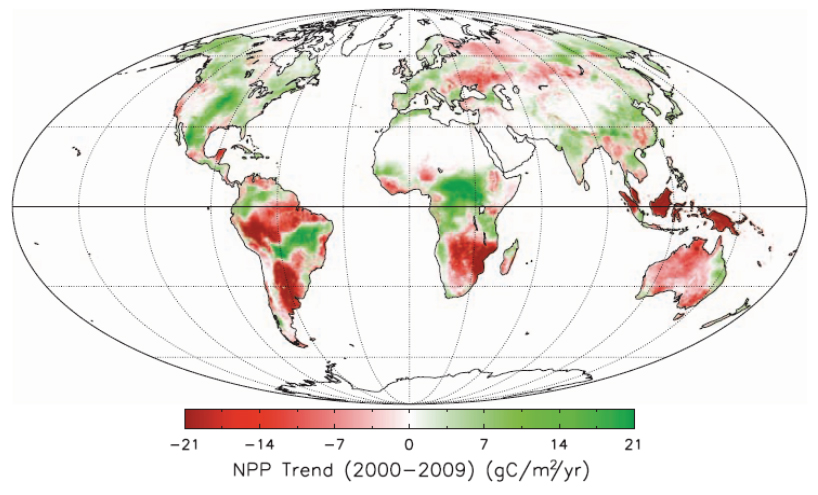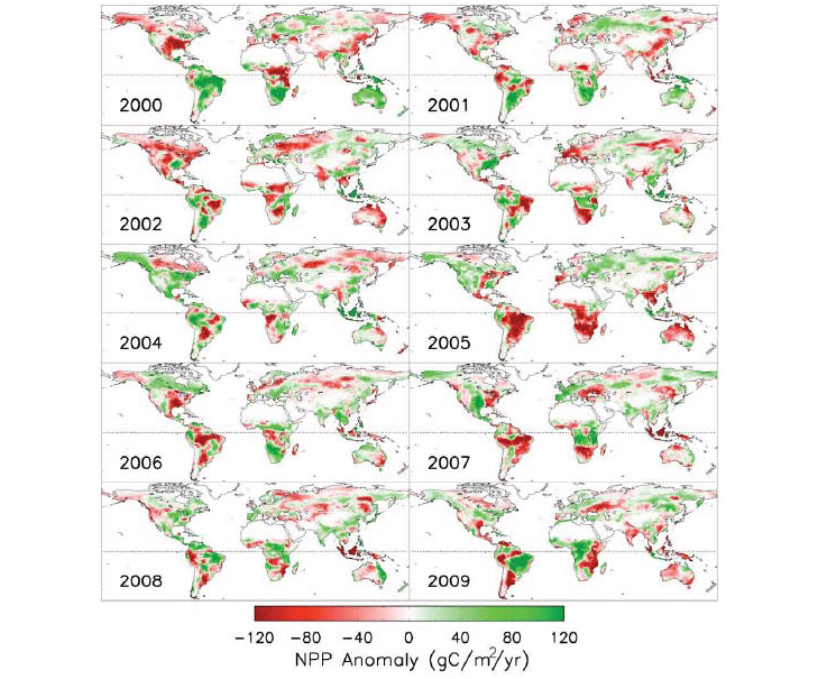|
Having trouble reading this email? Download the PDF.

Thematic Focus: Ecosystem Management and Climate Change
Plant Growth Declined Over the Past Decade
Why is this issue important?
Calculating Net Primary Production (NPP) is the first step in quantifying the amount of carbon plants fix from the atmosphere and accumulate as biomass. NPP is an important component of the global carbon cycle,
but it is also useful in estimating environmental change, such as desertification, deforestation, and disturbances such as fire and insect outbreaks; assessing the impacts of pollution and climate change; and evaluating
the status of ecosystems and their services, including habitat and wildlife condition and the size of ecological footprints. NPP is also a very useful measure to inform land management decisions and to estimate renewable natural resources.

What are the findings and implications?
In a paper published on 20 August 2010 in Science, researchers report that contrary to expectations, terrestrial biomass production has declined over the last decade (2000-2009) (Zhao and Running 2010).
In 2003, studies had shown that terrestrial biomass production had increased in line with rising global average temperatures (Nemani and others 2003). Satellite data estimating the amount of carbon stored in vegetation
between 1982 and 1999 had been used to monitor changes in biomass production. The long-term correlation with average surface temperatures had led to the conclusion that a warming climate generally enhances biomass production,
with positive implications for food availability.
Figure 1: Global distribution of change in carbon-stored biomass between 2000 and 2009 as calculated by Zhao and Running (2010).
Red areas represent decreased production; in green areas, NPP has increased; and white areas have not changed significantly.


Figure 2: Annual anomalies in carbon stored in biomass as calculated by Zhao and Running (2010). Note the droughts in parts of North America and China in 2000 and
in North America and Australia in 2002; a heat wave in Europe in 2003; and severe droughts in the Amazon, Africa and Australia in 2005.
The more recent report, however, has found evidence from similar satellite data (MODIS Terra) from 2000 to 2009 that terrestrial biomass production has decreased even though the decade has been the
warmest since records began. The main reason for the calculated reduction is thought to be a series of largescale droughts that occurred in various regions over the decade. Droughts in tropical regions
in particular have affected the net change, as most biomass and thus carbon is stored in tropical vegetation such as rain forests (see Figure 2 for annual anomalies and specific drought events).
The implications of this reverse effect are significant considering forecasts of even warmer years in the future - not only will this decrease crop yields and associated food security (in case of
more frequent droughts), but it also means less carbon than usual will be stored in terrestrial biomass, further perpetuating the rise in atmospheric CO2. A continued decline in NPP would
not only weaken the terrestrial carbon sink, but it would also intensify future competition between the demand for food and proposed biofuel production. The planet has a "finite plant-growth potential"
and decreasing NPP would set a stricter bound on that potential, meaning that society will have to make difficult decisions about how to use the given potential for plant growth.
References
Nemani, R., Keeling, C., Hashimoto, H., Jolly, W., Piper, S., Tucker, C., Myneni, R., Running, S. (2003). Climate-driven increases in global terrestrial Net Primary Production from 1982 to 1999. Science, 300 (5625), 1560-1563.
Zhao, M. and Running, S. (2010). Drought-induced reduction in global terrestrial Net Primary Production from 2000 through 2009. Science, 329 (5994), 940-943.
Information is regularly scanned, screened, filtered, carefully edited, and published for
educational purposes. UNEP does not accept any liability or responsibility for the accuracy, completeness, or any other quality of information and
data published or linked to the site. Please read our privacy policy and
disclaimer for further information.
|








